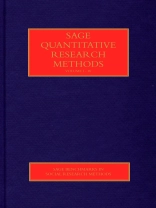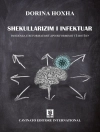For more than 40 years, SAGE has been one of the leading international publishers of works on quantitative research methods in the social sciences. This new collection provides readers with a representative sample of the best articles in quantitative methods that have appeared in SAGE journals as chosen by W. Paul Vogt, editor of other successful major reference collections such as
Selecting Research Methods (2008) and
Data Collection (2010).
The volumes and articles are organized by theme rather than by discipline. Although there are some discipline-specific methods, most often quantitative research methods cut across disciplinary boundaries.
Volume One: Fundamental Issues in Quantitative Research
Volume Two: Measurement for Causal and Statistical Inference
Volume Three: Alternatives to Hypothesis Testing
Volume Four: Complex Designs for a Complex World
विषयसूची
VOLUME 1: FUNDAMENTAL ISSUES IN QUANTITATIVE RESEARCH
General orientations
Ten Statisticians and Their Impacts for Psychologists – Daniel Wright
Conversations about Three Things – Howard Wainer
Minimally Sufficient Research – Christopher Peterson
On Quantitizing – Margarete Sandelowski
Experimental Methods
The External Validity of Experiments – Glenn Bracht and Gene Glass
Randomized Trials for the Real World: Making as Few and as Reasonable Assumptions as Possible – Stuart Baker and Barnett Kramer
Having One′s Cake and Eating It, Too: Combining true experiments with regression discontinuity designs – Marvin Mandell
Survey Research
Capture-Recapture and Anchored Prevalence Estimation of Injecting Drug Users in England: National and regional estimates – Gordon Hay et al
Constructing Summary Indices of Quality of Life: A model for the effect of heterogeneous importance weights – Michael Hagerty and Kenneth Land
Advances in Age-Period-Cohort Analysis – Herbert Smith
Selection Bias in Web Surveys and the Use of Propensity Scores – Matthias Schonlau et al
Methods for Missing Data
Estimation of Causal Effects via Principal Stratification When Some Outcomes Are Truncated by ‘Death’ – Junni Zhang and Donald Rubin
Multiple Imputation for Missing Data: A cautionary tale – Paul Allison
Multiple Imputation: Current perspectives – Michael Kenward and James Carpenter
Incomplete Hierarchical Data – Caroline Beunckens et al
VOLUME 2: MEASUREMENT FOR CAUSAL AND STATISTICAL INFERENCE
Measurement/Coding
The Cost of Dichotomization – Jacob Cohen
Fidelity Criteria: Development, measurement, and validation – Carol Mowbray et al
Controlling Error in Multiple Comparisons, with Examples from State-to-State differences in Educational Achievement – Valerie Williams, Lyle Jones and John Tukey
Surrogate Endpoint Validation: Statistical elegance versus clinical relevance – E.M. Green
Causation
Causation in the Social Sciences: Evidence, inference, and purpose – Julian Reiss
Statistical Models for Causation: What inferential leverage do they provide? – David Freedman
Identification of Causal Parameters in Randomized Studies with Mediating Variables – Michael Sobel
Matching Estimators of Causal Effects: Prospects and pitfalls in theory and practice – Stephen Morgan and David Harding
Suppressor Variables in Path Models – Gerard Massen and Arnold Baker
Program Evaluation and Individual Assessment
Are Simple Gain Scores Obsolete? – Richard Williams and Donald Zimmerman
Ten Difference Score Myths – Jeffrey Edwards
What Are Value-Added Models Estimating and What Does This Imply for Statistical Practice? – Stephen Raudenbush
Setting Targets for Health Care Performance: Lessons from a case study of the English NHS – Gwyn Bevan
Statistical Inference
Correcting a Significance Test for Clustering – Larry Hedges
The Insignificance of Null Hypothesis Significance Testing – Jeff Gill
A Comparison of Statistical Significance Tests for Selecting Equating Functions – Tim Moses
The Choice of Sample Size: A mixed Bayesian/frequentist approach – Hamid Pezeshk et al
VOLUME 3: ALTERNATIVES TO HYPOTHESIS TESTING
Confidence Intervals and Effect Sizes
Toward Policy-Relevant Benchmarks for Interpreting Effect Sizes: Combining effects with costs – Douglas Harris
Replication and p Intervals: p values predict the future only vaguely, but confidence intervals do much better – Geoff Cumming
Confidence Intervals About Score Reliability Coefficients, Please – Xitao Fan and Bruce Thompson
Finite Sampling Properties of the Point Estimates and Confidence Intervals of the RMSEA – Patrick Curran et al.
Meta-analysis
Integrating Findings: The meta-analysis of research – Gene Glass
Reliability Generalization: Exploring variance in measurement error affecting score reliability across studies – Tammi Vacha-Haase
The Relationship Between Sample Sizes and Effect Sizes in Systematic Reviews in Education – Robert Slavin and Dewi Smith
An Exploratory Test for an Excess of Significant Findings – John Ioannidis and Thomas Trikalinos
Expanded Information Retrieval Using Full-Text Searching – Ronald Kostoff
Correlation and Regression
Puzzlingly High Correlations in f MRI Studies of Emotion, Personality, and Social Cognition – Edward Vul et al
How Is a Statistical Link Established Between a Human Outcome and a Genetic Variant? – Guang Guo and Daniel Adkins
The Perils of Partialling – Donald Lynam et al
Weighting Regressions by Propensity Scores – David Freedman and Richard Berk
Logit and Probit Regression
Comparing Logit and Probit Coefficients across Groups – Paul Allison
An Additional Measure of Overall Effect Size for Logistic Regression Models – Jeff Allen and Huy Le
The Intermediate Endpoint Effect in Logistic and Probit Regression – D.P. Mackinnon et al
An Introduction to Crisp Set QCA with a Comparison to Binary Logistic Regression – Bernard Gofman and Carsten Schneider
Categorical Data Analysis
Univariate and Bivariate Loglinear Models for Discrete Test Score Distributions – Paul Holland and Dorothy Thayer
Testing for IIA in the Multinomial Logit Model – Simon Cheng and J. Scott Long
Goodness-of-Fit Tests and Descriptive Measures in Fuzzy-Set Analysis – Scott Eliason and Robin Stryker
Is Optimal Matching Suboptimal? – Matissa Hollister
VOLUME 4: COMPLEX DESIGNS FOR A COMPLEX WORLD
Structural Equation Modeling
The General Linear Model as Structural Equation Modeling – James Graham
Factor Retention Decisions in Exploratory Factor Analysis: A tutorial on parallel analysis – James Hayton et al
A Comparison of Item Response Theory and Confirmatory Factor Analytic Methodologies for Establishing Measurement Equivalence/Invariance – Adam Meade and Gary Lautenschlarer
The Importance of Structure Coefficients in Structural Equation Modeling Confirmatory Factor Analysis – Bruce Thompson
Multilevel Modeling
Multilevel Modeling: A review of methodological issues and applications – Robert Dedrick et al
Estimating Statistical Power and Required Sample Sizes for Organizational Research Using Multilevel Modeling – Charles Scherbaum and Jennifer Ferreter
From Micro to Meso: Critical steps in conceptualizing and conducting multilevel research – Katherine Klein and Steve Kozlowski
Growth Modeling Using Random Coefficient Models: Model building, testing, and illustrations – Paul Bliese and Robert Ployhart
Event History, Survival and Longitudinal Analyses
Multi-State Models for Event History Analysis – Per Kragh Andersen and Niels Keiding
Discrete-Time Survival Mixture Analysis – Bengt Muthen and Katherine Masyn
Multilevel Random Coefficient Analyses in Event- and Interval-Contingent Data in Social and Personality Psychology Research – John Nezlek
Business Cycles and Turning Points: A survey of statistical techniques – Michael Massmann et al
Computer-Intensive and Hi-Tech Spatial Analysis Methods
The Validity of Publication and Citation Counts for Sociology and Other Select Disciplines – Jake Najman and Belinda Hewitt
A Web Crawler Design for Data Mining – Marc Thelwall
Analysis of Terrorist Social Networks with Fractal Views – Christopher Yang and Marc Sageman
From Schelling to Spatially Explicit Modeling of Urban Ethnic and Economic Residential Dynamics – Itzhak Benenson
लेखक के बारे में
W. Paul Vogt is Emeritus Professor of Research Methods and Evaluation at Illinois State University where he won both teaching and research awards. He specializes in methodological choice and program evaluation and is particularly interested in ways to integrate multiple methods. His other books include: Tolerance & Education: Learning to Live with Diversity and Difference (Sage Publications, 1998); Quantitative Research Methods for Professionals (Allyn & Bacon, 2007); Education Programs for Improving Intergroup Relations (coedited with Walter Stephan, Teachers College Press, 2004). He is also editor of four 4-volume sets in the series, Sage Benchmarks in Social Research Methods: Selecting Research Methods (2008); Data Collection (2010); Quantitative Research Methods (2011); and, with Burke Johnson, Correlation and Regression Analysis (2012).His most recent publications include the coauthored When to Use What Research Design (2012) and Selecting the Right Analyses for Your Data: Quantitative, Qualitative, and Mixed Methods Approaches (2014).












